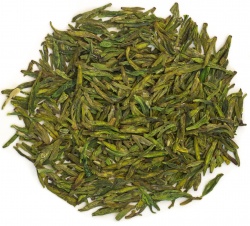Longjing tea
Longjing tea (龍井茶, lóngjǐng chá), sometimes called by its literal translated name Dragon Well tea, is a variety of green tea from Hangzhou, Zhejiang Province, China. The tea is mostly produced by hand and is renowned for its high quality, earning the China Famous Tea title.
Production process
Like most Chinese green tea, Longjing tea leaves are roasted after picking to stop the natural oxidation process. This process is also known as kill green.
Longjing tea leaves are picked during different periods of time. Generally, the best and most expensive tea is picked before the Qingming festival. This tea is called Mingqian tea. Tea picked later is called Yuqian tea (pre rain) and of lower quality. Most Longjing tea is still pan fried by hands. There are various methods for frying Longjing tea like buckle, grasp, pile, press, throw, toss and shake. Experienced masters know when to use the right technique according to color, moisture and temperature of the tea leaves.
Quality
The tea can be very expensive, and the prices depend on the varieties, of which there are many. Longjing is divided into six grades: Superior and then 1 down to 5. Infused leaves are a good indicator of quality, which is characterized by maturity and uniformity of the shoots harvested for processing. High quality Longjing teas produce tender, whole leaves that are uniform in appearance. Lower quality varieties may vary in color from bluish to deep green after steeping. Before infusion, higher quality Longjing teas have a very tight, flat shape and light green color. A study by Wang and Ruan (2009) found that one aspect of the perceived low quality of Longjing teas was a higher concentration of chlorophyll, producing a darker green color. The study revealed that free amino acids and theanine concentrations contribute positively to what is perceived as a good taste.
Origin
Authentic Dragon Well tea is grown in Zhejiang province in China around West Lake. The regions Shifeng Peak, Longjing Village, Yunxi Mountain, Hupao and Meijiawu offers best conditions for growing high quality tea. Longjing is generally classified into Xihu (West Lake) Longjing, Qiantang Longjing and Yuezhou Longjing. Xihu Longjing is considered as the best available Longjing tea. All these areas have a long history of planting tea trees. Even Lu Yu mentioned it in his book of tea.
However, a large majority of Longjing tea on the market is actually not from Hangzhou or even from Zhejiang. Many Longjing teas are produced in provinces such as Guangdong, Guizhou, Sichuan and Yunnan.
Varieties
- Xihu Longjing
- This Longjing, also known as West Lake Longjing, is the most famous of all China Famous Teas and is grown in the Zhejiang Province near Xihu (West Lake). Historically, Xihu longjing tea was divided into four sub-regions: Lion (Shi), Dragon (Long), Cloud (Yun) and Tiger (Hu). This categorization has been adjusted to Shifeng, Meijiawu, Yangmei Ling, Wengjia Shan, and Jiuxi Longjing.
- Shifeng Longjing
- A variety of Xihu Longjing from Shifeng Shan (Shifeng mountain). Fresh taste, sharp and long lasting fragrance. The leaves are yellow-green in color.
- Meijiawu Longjing
- A variety of Xihu Longjing from the Meijiawu village and renowned for its jade green color.
- Bird's Tongue Longjing
- First growth picked on about March 21 yields a more intense aroma and taste of sweetness than the better known Ming Qian Longjing. Supply is highly dependent on climate.
- Pre-Qingming Longjing
- The premium early season first-picking known as Ming Qian or Pre-Qingming (or Before Ching Ming) Longjing tea requires it to be produced from the first spring shoots prior to the Qingming Festival on the 5th of April each year (approximately). The production cycle is very short, usually only ten days before Qingming every year. Tea picked after this period is of a lower grade called Yuqian Longjing (雨前龍井) (pre rain).
- Anji Baicha
- Not a genuine Longjing but looks like one and is commonly attributed. This tea is actually a Bai Cha. This tea is produced in Anji, Zhejiang province.
- Qiantang Longjing
- This Longjing comes from outside the Xihu district and is less expensive as Xihu Longjing.


